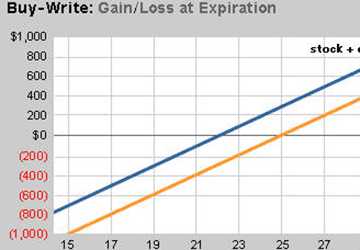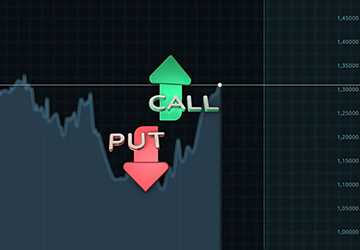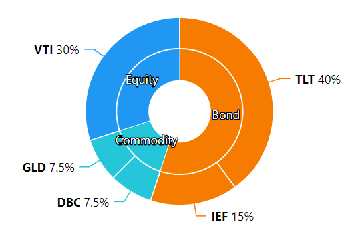Simply put, a buy-write trade involves holding a long position in a stock and selling a call option on that stock. The investor receives a premium for selling the call option, which can provide a steady income stream. If the stock price rises above the call option's strike price before it expires, the investor might be required to sell the stock at the strike price. However, they get to keep the premium they initially received.
Example of a Buy-Write Trade
Consider an investor who buys 100 shares of XYZ Company at $50 per share and sells. Consider purchasing call options with a strike price of $55, where the premium is $2 per share.

Scenario 1: If the stock price remains below $55, the options expire worthless. The investor keeps the $2 premium per share and owns the stock.
Scenario 2: The options are exercised if the stock price rises to $60. The investor sells the stock at $55, earning $5 per share from the increase plus the $2 premium per share, for a total profit of $7 per share.
Mechanics of a Buy-Write Trade
A buy-write trade involves two main actions: buying a stock and writing (selling) a call option on that stock. Here’s a step-by-step breakdown of how it works:
Buy the Stock
The investor starts by purchasing shares of a particular stock. This could be a new purchase or shares the investor already owns.
Sell the Call Option
At the same time, the investor sells a call option on the same stock. A call option gives the buyer the right, but not the obligation, to purchase the stock at a specified price within a certain period (until the expiration date).
Receive Premium
In return for selling the call option, the investor receives a premium from the option buyer. This premium is the income generated from the buy-write strategy.
Possible Scenarios
Stock Price Below Strike Price
If the stock price stays below the strike price until the option's expiration date, the option expires worthless. The investor keeps both the premium and the stock.
Stock Price Above Strike Price
If the stock price rises above the strike price, the option buyer exercises the option. This means the investor must sell the stock at the strike price. In this scenario, the investor benefits from the stock's price appreciation up to the strike price and keeps the premium received from selling the option.
Benefits of a Buy-Write Trade
A buy-write trade offers several advantages for investors, balancing potential returns with risk management. Here are the key benefits:
Income Generation
One of the primary benefits of a buy-write strategy is the additional income generated through premiums from selling call options. This can provide a steady stream of cash flow, which is especially valuable in flat or slowly rising markets. By selling call options regularly, investors can supplement their income from dividends, enhancing the overall yield of their portfolio.
Downside Protection
The premium from selling the call option offers a buffer against potential losses. This can reduce the overall impact of a stock price decline, protecting the investor's portfolio. The income from the premiums can help offset minor decreases in the stock's value, providing a measure of downside protection.
Enhanced Returns in Low-Volatility Markets
The buy-write strategy can enhance returns in markets where stock prices are not expected to rise significantly. Premium income can offset limited gains in stock prices. This strategy is particularly effective in low-volatility environments where significant price movements are not anticipated.
Discipline and Consistency
Implementing a buy-write strategy requires a systematic approach to selling call options. This can instil discipline in an investor's trading habits. Regularly selling call options enforces a consistent investment process and can prevent emotional decision-making based on market fluctuations.
Risks of a Buy-Write Trade
While a buy-write trade offers several benefits, it also carries potential risks that investors need to be aware of:

Limited Upside Potential
When using a buy-write strategy, the upside potential is capped. If the stock price rises significantly above the strike price, the investor misses out on potential gains because they must sell the stock at the strike price. This means that in a rapidly rising market, the investor's profit is limited to the strike price plus the premium received.
Stock Price Decline
While the premium provides some downside protection, it may not fully cover significant losses if the stock price falls sharply. In the case of a substantial market downturn, the premium received may not be enough to offset the decline in the stock’s value.
Opportunity Cost
By committing to a buy-write strategy, investors might miss out on better investment opportunities during the call options' holding period. The obligation to hold onto the stock until the option expires can prevent investors from reallocating their capital to more lucrative investments.
Requires Active Management
To be effective, a buy-write strategy needs continuous monitoring and management. Investors must regularly evaluate market conditions and adjust their positions accordingly. Managing investments actively can be time-consuming and requires more market knowledge and involvement than a passive investment strategy.
Ideal Situations for Buy-Write Trades
The buy-write strategy is effective in certain market conditions and for specific investor goals. Here are some ideal situations for using buy-write trades:
Moderate Bull Market: This strategy works well in a moderate bull market where the stock is expected to rise slowly. The stock gradually appreciates, allowing you to collect premiums while benefiting from price gains.
Stable Markets: In flat or mildly volatile markets, the premium income from selling call options provides a steady return. The stock price remains relatively unchanged, making the possibilities less likely to be exercised. You retain both the premium and the stock.
Tax Management: In specific tax environments, buy-write strategies can help manage tax liabilities. The premiums received can be capital gains, which could be subject to a lower tax rate than regular income.
Conclusion
The buy-write trade is a versatile strategy for investors looking to generate additional income while maintaining exposure to stock ownership. It balances potential returns and risk management, making it suitable for moderate market conditions.
By incorporating the buy-write trade into your investment strategy, you can enhance your returns and manage risk more effectively, making it a valuable tool for your financial portfolio in 2024.


